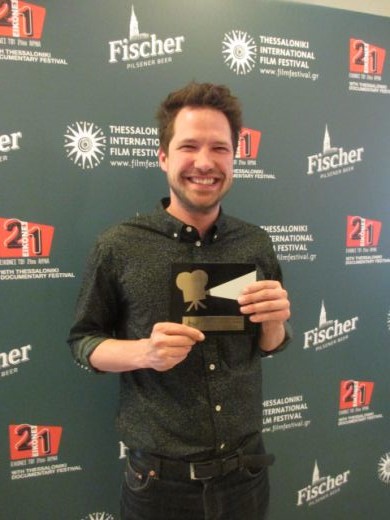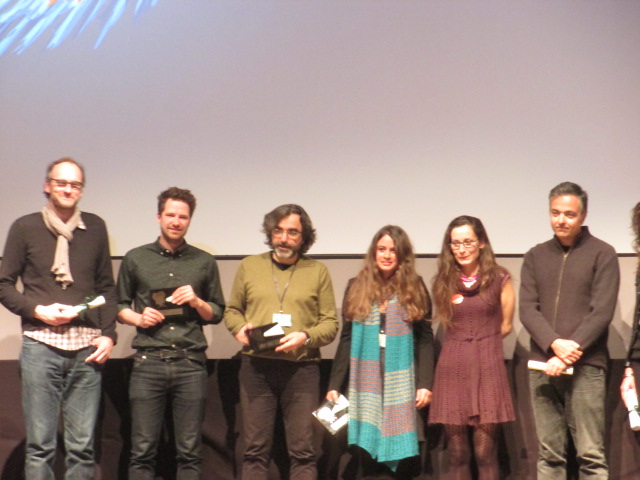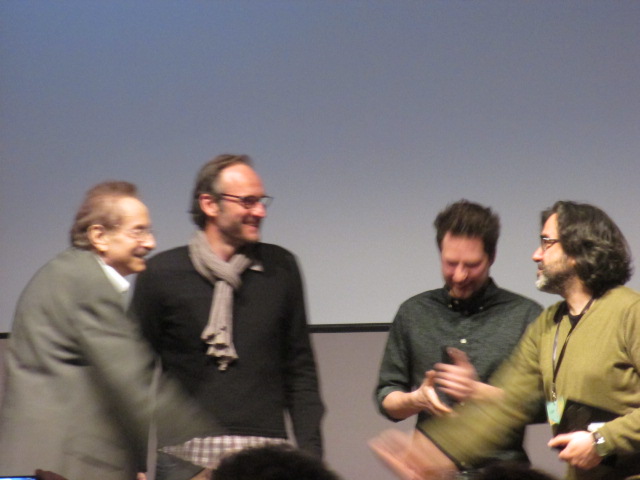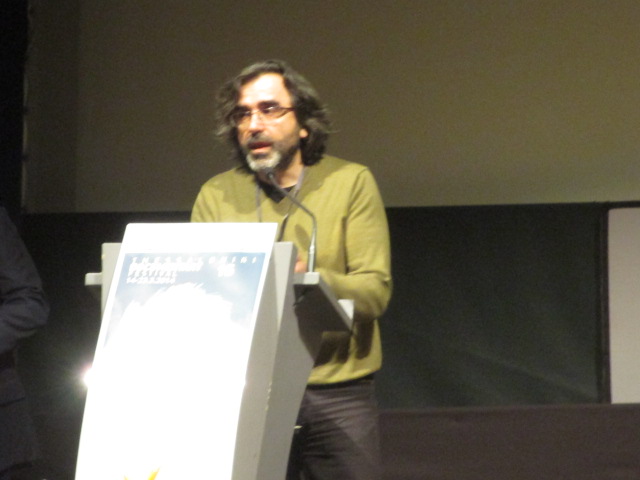|
|
||
|
Pro Tools
FILMFESTIVALS | 24/7 world wide coverageWelcome ! Enjoy the best of both worlds: Film & Festival News, exploring the best of the film festivals community. Launched in 1995, relentlessly connecting films to festivals, documenting and promoting festivals worldwide. Working on an upgrade soon. For collaboration, editorial contributions, or publicity, please send us an email here. User login |
THE PEASANT AND THE PRIEST, an interview with Esther Podemskiphoto stills from the film Interview with Esther Podemski on THE PEASANT AND THE PRIEST (USA, 2011), a story about two old men in Italy whose ways of life have been unchanged through the centuries from medieval times to present day where the old ways are dying to contemporary forces causing much of what we know as Italy to fade a little more with each march towards modernization and mass globalization. In Thessaloniki I had the opportunity to sit with director Esther Podemski to speak about her magnum opus documentary project which finally came to a close in 2010. As this was truly one of the best docs I have seen of late, it was a pleasure to watch and speak at length about. The film runs at 47’ but leaves you wanting more as it is powerful and hits on a subject on Italian modern culture not yet explored enough in my opinion. Well, I’ll get started with the interview and express more opinions about the film as we go.
ME: Hello Esther, so your film is called THE PEASANT AND THE PRIEST. Can you speak a little bit about what inspired you to make the film? ESTHER: Well, initially I met Sergio the peasant, Sergio Ermini, on my first trip to Italy. I went with my family. And at this villa which was not in the best of shape but beautiful and unchanged was Sergio who is a Tuscan peasant. He is a Mezzadro, and a Mezzadro is a Tuscan sharecropper and he had been there for over fifty years. There was nobody else there and I knew the person who was his landowner. She wasn’t there but he was there with his family. He was the living embodiment of the social structure that had formed Tuscany. This land is very idealized. Everybody loves Tuscany right? ME: Yeah, of course! ESTHER: So, I thought I would make a film about his farming methods, but that didn’t work out for various reasons. I mean, I brought it back to America and it looked kind of like an old guy on a 45 year old tractor, which is his most sophisticated piece of equipment. And anyway, I expanded this film to include this priest. And the priest works with women who are trafficked and it’s a story about parallel lives, two men who represent ancient vocations and their confrontation with modernity. They were born and they died in the same year which I didn’t know until I was well into the story. ME: So, how long did it take you to make this film? ESTHER: Should I tell you the truth? [we both laugh] ME: Yes! This is a documentary. We only want the truth here! ESTHER: It took me eight years, which sounds ridiculous because, you know, it’s only 47 minutes. It took me that long because I quit for a couple of years out of frustration. I was very discouraged because I wasn’t getting any response. But my background is as a visual artist. So, what I learned in art school was you have to finish the painting [laughs]. You have to finish it! And I guess that once I start something I have to finish it. It’s a compulsion. It’s good. ME: It's a good compulsion! ESTHER: It sounds sort of ridiculous that the film took me eight years. ME: Not at all! You finished a film. That is a great feat! And for some people it can take longer. It depends greatly on how much help there is. I’m so glad you did. It’s a beautiful work. I believe you should make it a feature length even. I just believe the parallel in your film is very important to modern day issues in Italy. I lived in Italy for two years so I’ve seen the issue at hand up close and it has not really been brought to light in film so much, not yet anyway, which is one of Italy’s darker sides and certainly not what people want to imagine when they think of glorious romantic Tuscany. ESTHER: Well, I think that what struck me is when I landed in Rome and as we were driving to Tuscany on the country roads, I was seeing these black women, some of who were wearing the traditional clothing. I assume they were Nigerian because that’s the largest group of enslaved prostitutes in Italy and I thought, ‘oh, how picturesque! Look at this beautiful black woman underneath a parasol on the side of the road!’ And then I thought, ‘Wait a minute, who is she and why is she here?’ You know, and then, the more I saw of them, it became clear to me that these were prostitutes and then progressively I learned that there were many of them…It just struck me as so strange, because there are so many of them, especially in Florence walking the streets at night. It’s just the juxtaposition of our idealization of the region, our myth about Italy and particularly this well-loved region of Tuscany. The juxtaposition of this form of exploitation and reality just was really kind of shattering and that kind of observation led me to Father Oreste Benzi. ME: Well, you’ve really hit on something though about modern Italian culture. We’ve seen so much about mafia but not about the trafficking issue that is becoming more and more of a problem. Anyone who has traveled there can see this problem. It is clear these women are in a desperate situation. ESTHER: They’re exploited. They come from Nigeria predominantly and they come from the former Soviet Block of the poorest countries in Europe. Moldova has the distinction of being the poorest country in Europe. And when you read the literature and you talk about the subject with activists you realize how terribly exploited they are and what motivates them to leave and you know it’s really heartbreaking. And I guess what I like about Oreste Benzi in terms of that aspect of the film is that he had a larger philosophical faith about what causes these circumstances and he realizes that it’s poverty and it’s poverty that drives people to these mass migrations, that allows them to leave their families or where their parents permit this for their young daughters because he himself was poor. And he gives this poverty speech early on and I was touched by that. It wasn’t simplistic. It had a real philosophical base but he had a deep understanding because he understood poverty himself and what drives people and how it destroys their self-image as individuals. ME: And I think that goes for all forms of poverty. Not just monetary, but spiritual poverty, family and love poverty because I think that’s what is universal. That’s what I loved about this film. How you start with that speech from Benzi about the explanation of how these people almost apologize for being alive. And that’s insecurity. Everyone is insecure from some form of poverty or lack of something in their lives or feeling of self-worth. Even around rich or successful people, there is a gaping hunger and form of another poverty present and that is what, for me, makes this story universal. It doesn’t matter if you’re rich or poor, people all over struggle with that feeling of worthlessness so it makes one connect even more to the women portrayed in your film. ESTHER: Oh thank you! I haven’t heard that before. ME: Can you talk about the classic Renaissance painting/fresco used which you inter-weave throughout the film? That was very cleverly done, mixing past with present, art with hard reality. The fresco painting of THE ALLEGORY OF GOOD AND BAD GOVERNMENT (by Ambrogio Lorenzetti, 14th century). ESTHER: Yes, thank you. Well, the painting is, in part, about the romanticism we have of certain areas. Just using Italy as an example, there’s Venice. The reality in Venice is that the Venetians can hardly afford to live. It’s a prop. And then there’s Tuscany with its expatriates…You know, there’s Germans, Americans, Brits. Tuscany has always had this allure. It’s always had this idealization in the popular imagination. There’s a long history of that. But I decided to use the painting, because I had two characters and they never converge in the film. I always knew about the painting and it’s very famous. I thought that would be a way of unifying the characters because the painting is very complex and we could actually find these people in the painting among many other classes of people. The painting has three panels- good and bad government, good government with the good city and republic and the good countryside. And in terms of the good panel the city and the country reflect each other so when you look out onto the countryside it reflects the city so it’s kind of an ecological statement. ME: Oh yeah! For sure! ESTHER: and then you have the bad government, which does the same thing, it’s a reflection but everything in the countryside and city is burning, and you have all these classes operating together. In the good government panels we see harmony and then in the middle panel you have the power structure or the court of justice and it looks over and it’s about the virtues of a republic that creates responsible government in the city. ME: Well, it works very well in the film. I mean, most of the time we are looking at these paintings with these archetypes and symbols and wondering ‘what does it mean?’ so it’s very useful and important to attribute meaning from such an old painting and apply it to modern life in the same region represented in the painting. The painting is drawing on timeless human issues no? ESTHER: It is timeless. That’s why it’s great and what I noticed is more and more I have been reading stuff in which people look to the painting in modern literature. For instance, Adam Gopnik had this article in the New Yorker about Adam Smith and he referenced the painting as a kind of counter argument to the Adam Smith concept, that maybe it isn’t good to have more and more profit. Maybe what’s better, and what the painting suggests, is to try to strike balance a harmony. ME: Right. I mean, that’s what it’s all about. Great art is timeless for a reason. The archetypes and symbols of being human that never die. ESTHER: Right. And in a way, I don’t want it to be a film about nostalgia or the idealization of the past but on the other hand what interests me in filmmaking is this glimpse of the world, of certain aspects of the world and a point of distinction, just as something is vanishing, just as its vanishing forever. And that is one of the magic aspects of film for me. ME: Oh, for sure, yeah. And then both then men in your film died! That’s really powerful because if you captured something that if you tried to do it now, you wouldn’t be able to, not with those people and not in that time or space. It’s not something you could ever do again. The documentary in that sense is a living thing. ESTHER: Yeah, it’s an aspect, a monument, a remembrance that is so powerful. Like when you see a section of the Curtis film which lasts only 45 seconds in the museum in British Columbia of war canoes, and when you see these North Coast Indians, even though it’s staged, that’s magic. That’s going back to a point of time that’s completely gone and one of the most powerful aspects of filmmaking. ME: Exactly. You’re making a timeline. You’re capturing something that is not going to be there tomorrow and someone in the future will be able to look back. I mean, you look at paintings and someday people will look at these films. It’s essential to document for our education and posterity. ESTHER: I totally agree. ME: So, what’s next for you after this long journey? ESTHER: Well, this is the first festival and I want the film to be seen so before I start a new project I want to see it through that process. I mean, I had an editor and everything but it’s really been just me doing everything, creating financing etc. ME: Actually, I did want to ask you how you produced this. Was it difficult? ESTHER: Well, it was an extremely difficult production and I really had to self-finance it for a long time. And it wasn’t till it was at a very developed state that I could go about and start begging, and this is my favorite thing. [I laugh hysterically now because I know she is being facetious because it is not a fun task if you are an artist] and so it was a bit of a strain. But apart from travel and airfares, etc., it was pretty low budget. ME: So, you’re just at the beginning of your festival run then. It’s a 2010 film so you can still enter it into festivals all this year. ESTHER: This is my third film. My previous films I had more help with grants but funding has changed a lot in documentary filmmaking. ME: And distribution! And all filmmaking for that matter. Everyone’s in limbo right now. And yet there’s a greater demand than ever for good films. It’s just how to make it so the industry can support itself. Well, I think one way that you can sell this film to buyers. ESTHER: And what is that? ME: Well, this is tasteless, but so are many buyers- LOL- you could rename it as: ‘Prostitutes and Olive Oil’. [Esther laughs aloud] just if you want to make some real attention. LOL. Can you tell us more about the peasant culture of Italy? ESTHER: So the relationship to the olive tree and the vine growing on the tree and in between them were all of this cultivation in small plots. Well, this is coming back. Sustainable agriculture is bringing this intensive cultivation in small plots back and that’s what made this land so beautiful. The recreation of an arid region into this intensive cultivation that was done by this peasant culture and that peasant culture formed the cultural landscape of Tuscany. So, when the peasantry was abolished all of these farmhouses where then vacated, in the early 70s, they were all emptied. And then all of these people, these Americans would come back and renovate. Meanwhile, the peasants lived in housing developments. And the cuisine of the area which has now become so expensive and so turn your nose up kind of deal, that was the peasant cuisine. They used all the leftovers. The peasantry would go out into the fields and pick herbs and grasses. It was a culture of no waste. Nothing was ever thrown away. So, they were inherently so forward looking. ME: It’s always that way. The elites always take what is popular (arts, cuisine, culture, etc.) and appropriate it making it theirs and the original thing loses its former simplicity. ESTHER: Exactly. A lot of people look at this as sort of nostalgia, but it isn’t about nostalgia, it’s about history. Well, we ended the interview there. Let those words sum up Esther’s lyrical and emotionally arresting film THE PEASANT AND THE PRIEST, ‘it isn’t about nostalgia, it’s about history.’
Interview and transcription by Vanessa McMahon, March 22, 2011 Read more about the film on Esther’s site here: http://www.thepeasantandthepriest.com/fresco.php from GOOD AND BAD GOVERNMENT fresco by Ambrogio Lorenzetti, 14th century Director Esther Podemski (left) and producer Miriam Hess (right) 22.03.2011 | Thessaloniki's blog Cat. : Adam Gopnik Adam Smith Ambrogio Lorenzetti America an interview with Esther Podemski Artist British Columbia Brits Contact Details Director editor Entertainment Entertainment Esther Podemski Europe finance Florence http://www.thepeasantandthepriest.com/fresco.php Italy Midwinter Graces Miriam Hess Next Magazine Nigeria Person Career Person Location Person Travel priest Producer Rome Sergio Ermini Social Issues Social Issues Technology Technology The New Yorker THE PEASANT AND THE PRIEST THE PEASANT AND THE PRIEST Tuscany UN Court Vanessa McMahon Venice You Got to Move
|
LinksThe Bulletin Board > The Bulletin Board Blog Following News Interview with EFM (Berlin) Director
Interview with IFTA Chairman (AFM)
Interview with Cannes Marche du Film Director
Filmfestivals.com dailies live coverage from > Live from India
Useful links for the indies: > Big files transfer
+ SUBSCRIBE to the weekly Newsletter Deals+ Special offers and discounts from filmfestivals.com Selected fun offers
> Bonus Casino
User imagesAbout Thessaloniki Mcmahon Vanessa Mcmahon Vanessa Vanessa McMahon Covered the 13th and 14th, and 16th edition. Through its tributes, it focuses both on discovering filmmakers with a unique cinematic point of view, and on the internationally recognized for their contribution to documentary. Contributions from Buno Chatelin http://tdf.filmfestival.gr/default.aspx?lang=en-US&loc=6&page=760 View my profile Send me a message My festivalThe EditorUser contributions |




























